Numerical Analysis of the Effect of Floor Depression on the Extent of Thermal Interaction with the Ground and Energy Management Using a Vegetable Cold Store as an Example
Abstract
:1. Introduction
2. Materials and Methods
2.1. Research Object
2.2. Measuring Equipment
2.3. Calculation Methods and Tools
3. Results
3.1. Validation of the Computational Model
3.2. Verification of the Calculation Model
3.3. Heat Exchange with the Ground and Energy Balance of Cold Storage Facilities—Existing Condition
3.4. Heat Exchange with the Ground and Energy Balance of Cold Storage—Theoretical Variant with Floor Recessed into the Ground
4. Discussion
5. Conclusions
Author Contributions
Funding
Data Availability Statement
Conflicts of Interest
Nomenclature
| ΔQ | increase in internal energy of the element (J) |
| C | total heat capacity of the element (J·K−1) |
| Δθ | element temperature increase (K) |
| v | element volume (m3) |
| c | specific heat of the element material (J·kg−1·K−1) |
| ρ | material density (kg·m−3) |
| i | element number |
| Φixiyiz,… | heat flux flowing between element ix and iy and iz and neighboring elements (W) |
| heat flux density (heat flow density) (W·m−2) | |
| λ | thermal conductivity coefficient of the element material (W·m−1·K−1) |
| ∇ | Hamilton’s vector operator |
| temperature gradient (K·m−1) | |
| ΣΦ | the sum of heat flows between individual elements (J) |
| θk+1 | temperature at time step k + 1 (K) |
| θk | temperature at time step k (K) |
| Δτ | time step (s) |
| mi | measured parameter |
| n | number of measured data |
| si | calculated parameter |
| mean value of measured parameters | |
| p | number of adjustable model parameters |
| NMBE | normalized mean bias error |
| CV(RMSE) | coefficient of variation of the root mean square error |
References
- Song, M.; Mao, N.; Xu, Y.; Deng, S. Challenges in, and the development of, building energy saving techniques, illustrated with the example of an air source heat pump. Therm. Sci. Eng. Prog. 2019, 10, 337–356. [Google Scholar]
- Sher, F.; Kawai, A.; Gulec, F.; Sadiq, H. Sustainable energy saling alternatives in small buildings. Sustain. Energy Technol. Assess. 2019, 32, 92–99. [Google Scholar]
- Sokołowski, P.; Nawalany, G. Analysis of Energy Exchange with the Ground in a Two-Chamber Vegetable Cold Store, Assuming Different Lengths of Technological Break, with the Use of a Numerical Calculation Method—A Case Study. Energies 2020, 13, 4970. [Google Scholar] [CrossRef]
- Martin, S.; Canas, I. A comparison between underground wine Cellary and aboveground storage for the aging of Spanish wines. Trans. ASABE 2006, 49, 1471–1478. [Google Scholar] [CrossRef]
- Nawalany, G.; Sokolowski, P.; Herbut, P.; Angrecka, S. Development of selected parameters of microclimate in a stand alone cellar plunged into soil. J. Ecol. Eng. 2017, 18, 156–161. [Google Scholar] [CrossRef]
- Sun, D.-W.; Wang, L. Experimental investigation of performance of vacuum cooling for commercial large cooked meat joints. J. Food Eng. 2004, 61, 527–532. [Google Scholar] [CrossRef]
- Comodi, G.; Carducci, F.; Sze, J.Y.; Balamurugan, N.; Romagnoli, A. Storing energy for cooling demand management in tropical climates: A techno-economic comparison between different energy storage technologies. Energy 2017, 121, 676–694. [Google Scholar] [CrossRef]
- Mazzeo, T.; Paciulli, M.; Chiavaro, E.; Visconti, A.; Pellegrini, N. Impact of the industrial freezing process on selected vegetables—Part II. Colour and bioactive compounds. Food Res. Int. 2015, 75, 89–97. [Google Scholar] [CrossRef]
- Zhang, Z.; Sun, D.-W. Effect of cooling methods on the cooling efficiencies and qualities of cooked broccoli and carrot slices. J. Food Eng. 2006, 77, 320–326. [Google Scholar] [CrossRef]
- Phillips, K.M.; Council-Troche, M.C.A.; McGinty, R.C.; Rasor, A.S.; Tarrago-Trani, M.T. Stability of vitamin C in fruit and vegetable homogenates stored at different temperatures. J. Food Compos. Anal. 2016, 45, 147–162. [Google Scholar] [CrossRef]
- Wu, Z.S.; Zhang, M.; Wang, S. Effects of high pressure argon treatments on the quality of fresh-cut apples at cold storage. Food Control 2012, 23, 120–127. [Google Scholar] [CrossRef]
- East, A.R.; Smale, N.J.; Trujillo, F.J. Potential for energy cost savings by utilizing alternative temperature control strategies for controlled atmosphere stored apples. Int. J. Refrig. 2013, 36, 1109–1117. [Google Scholar] [CrossRef]
- Xu, Y.; Zeng, Z.; Sun, D. Experimental and numerical investigation on heat transfer characteristics of vertical ground heat exchangers in karst areas. Energy Build. 2022, 275, 112481. [Google Scholar] [CrossRef]
- Bae, S.; Nam, Y.; Lee, E.-J. Evgueniy Entchev, Feasibility study of a novel hybrid energy system combining photovoltaic-thermal and modular ground heat exchanger. J. Build. Eng. 2022, 61, 105241. [Google Scholar] [CrossRef]
- Cui, P.; Yang, W.; Zhang, W.; Zhu, K.; Spitler, J.D.; Yu, M. Advances in ground heat exchangers for space heating and cooling: Review and perspectives. Energy Built Environ. 2024, 5, 255–269. [Google Scholar] [CrossRef]
- Cui, P.; Yang, H.; Fang, Z. Numerical analysis and experimental validation of heat transfer in ground heat exchangers in alternative operation modes. Energy Build. 2008, 40, 1060–1066. [Google Scholar] [CrossRef]
- Florides, G.; Kalogirou, S. Ground heat exchangers—A review of systems, models and applications. Renew. Energy 2007, 32, 2461–2478. [Google Scholar] [CrossRef]
- DECC. DUKES—Domestic Energy Consumption in the UK 2011; DECC: London, UK, 2011. [Google Scholar]
- SDC. Stock Take Delivering Improvements in Existing Housing; Sustainable Development Commission: London, UK, 2006. [Google Scholar]
- González, V.G.; Ruiz, G.R.; Bandera, C.F. Ground characterization of building energy models. Energy Build. 2022, 254, 111565. [Google Scholar] [CrossRef]
- Abergel, T.; Dulac, J.; Hamilton, I.; Jordan, M.; Pradeep, A. Global Status Report for Buildings and Construction—Towards a Zero-Emission, Efficient and Resilient Buildings and Construction Sector; United Nations Environment Programme: Nairobi, Kenya, 2019. [Google Scholar]
- Gdula, S. Przewodzenie Ciepła; PWN: Warszawa, Poland, 1984. [Google Scholar]
- PN-EN ISO 6946:2017-10; Building Components and Building Elements—Thermal Resistance and Thermal Transmittance—Calculation Methods. ISO: Geneva, Switzerland, 2017.
- Ruiz, G.R.; Bandera, C.F. Validation of calibrated energy models: Common errors. Energies 2017, 10, 1587. [Google Scholar] [CrossRef]
- González, V.G.; Colmenares, L.Á.; Fidalgo, J.F.L.; Ruiz, G.R.; Bandera, C.F. Uncertainy’s indices assessment for calibrated energy models. Energies 2019, 12, 2096. [Google Scholar] [CrossRef]
- Sun, D.W.; Wang, L. Heat transfer characteristics of cooked meats using different cooling methods. Int. J. Refrig. 2000, 23, 508–516. [Google Scholar] [CrossRef]
- Bambara, J.; Athienitis, A.K. Energy and Economic Analysis for greenhouse Ground Insulation Design. Energies 2018, 11, 3218. [Google Scholar] [CrossRef]
- Dong, C. Heat Loss via Concrete Slab Floors in Australian Houses. Procedia Eng. 2017, 205, 108–115. [Google Scholar]
- You, T.; Yang, H. Feasibility of ground source heat pump using spiral coil energy piles with seepage for hotels in cold regions. Energy Convers. Manag. 2020, 205, 112466. [Google Scholar] [CrossRef]
- Qian, H.; Wang, Y. Modeling the interactions between the performance of ground source heat pumps and soil temperature variations. Energy Sustain. Dev. 2014, 23, 115–121. [Google Scholar] [CrossRef]
- Liu, P.; Wu, Q.; Hu, W.; Tian, K.; Huang, B.; Zhao, Y. Effects of atmospheric deposition on heavy metals accumulation in agricultural soils: Evidence from field monitoring and Pb isotope analysis. Environ. Pollut. 2023, 330, 121740. [Google Scholar] [CrossRef]
- Nawalany, G.; Sokołowski, P.; Lendelova, J.; Zitnak, M.; Jakubowski, T.; Atilgan, A. Numerical analysis of the heat exchange model with the ground on the example of a complex of industrial halls. Energy Build. 2023, 300, 113689. [Google Scholar] [CrossRef]
- Moreira, M.; Silva, T.; Dias-de-Oliveira, J.; Neto, F.; Amaral, C. Numerical modelling of radiant systems and phase change materials in building applications—A review. Appl. Therm. Eng. 2023, 234, 121342. [Google Scholar] [CrossRef]
- Andersen, J.E.T.; Moemedi, K.; Katse, K. Modeling uncertainty by the principle of pooled calibrations and issues with method validations may influence consensus in science. Measurement 2022, 188, 110382. [Google Scholar] [CrossRef]

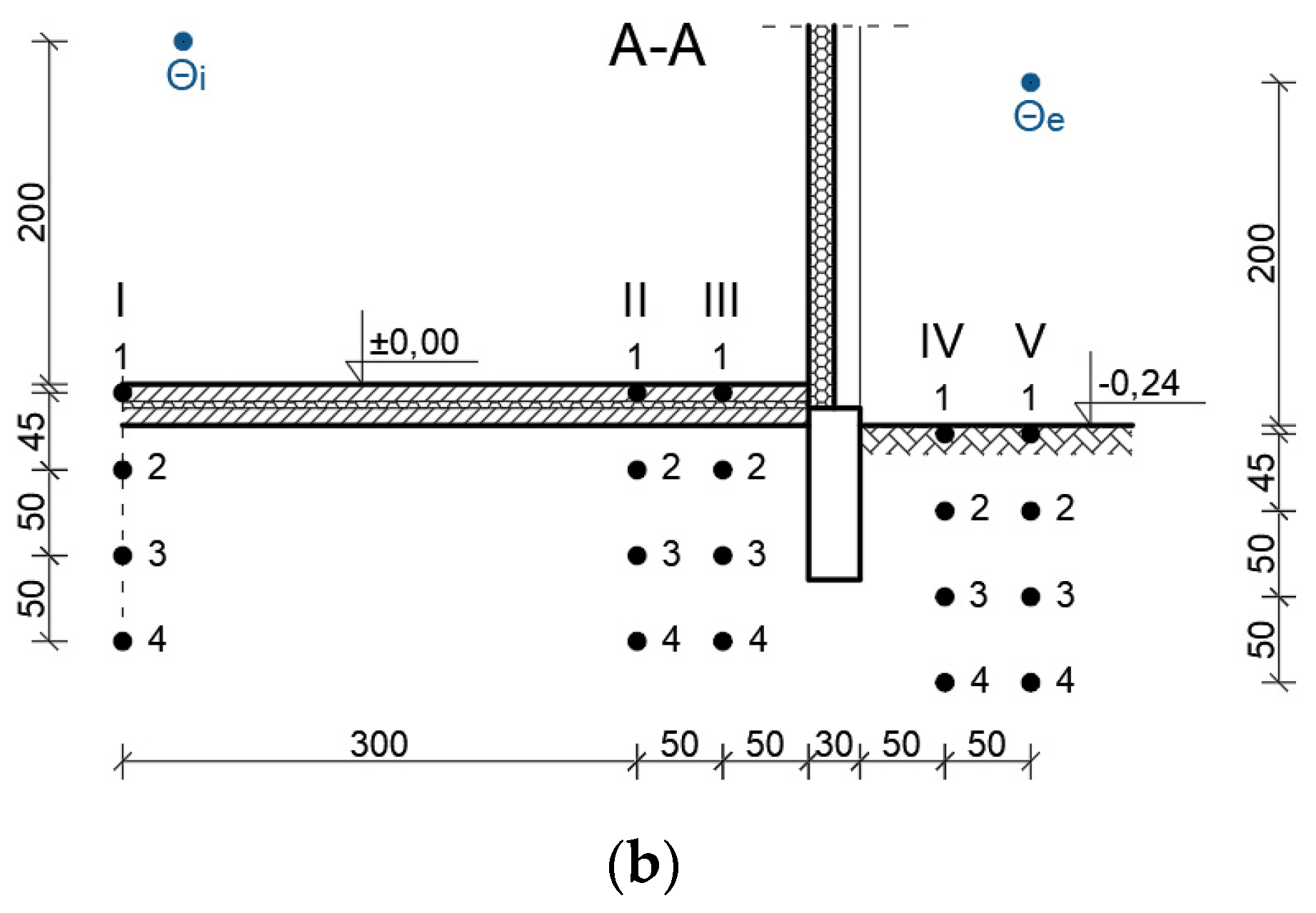


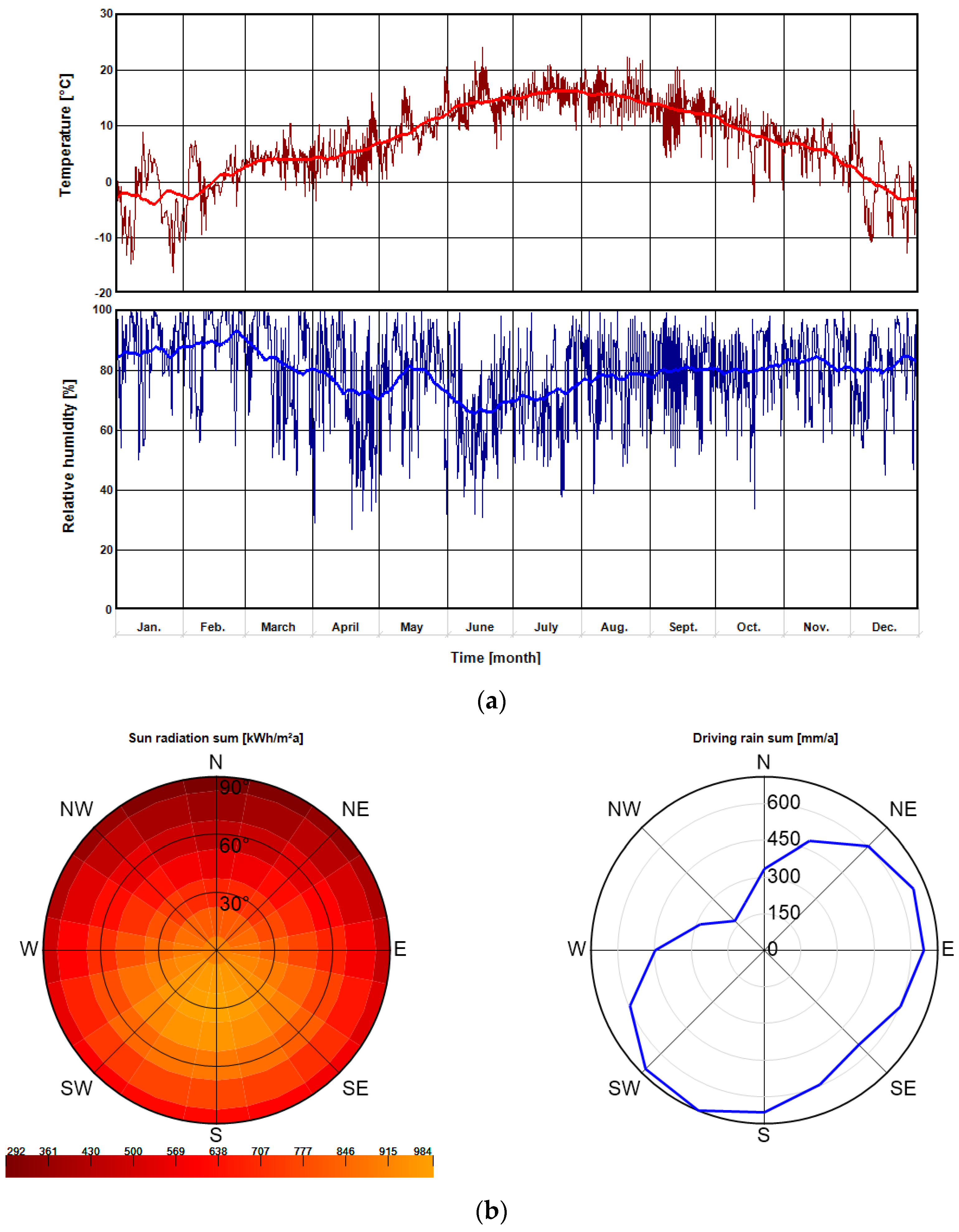
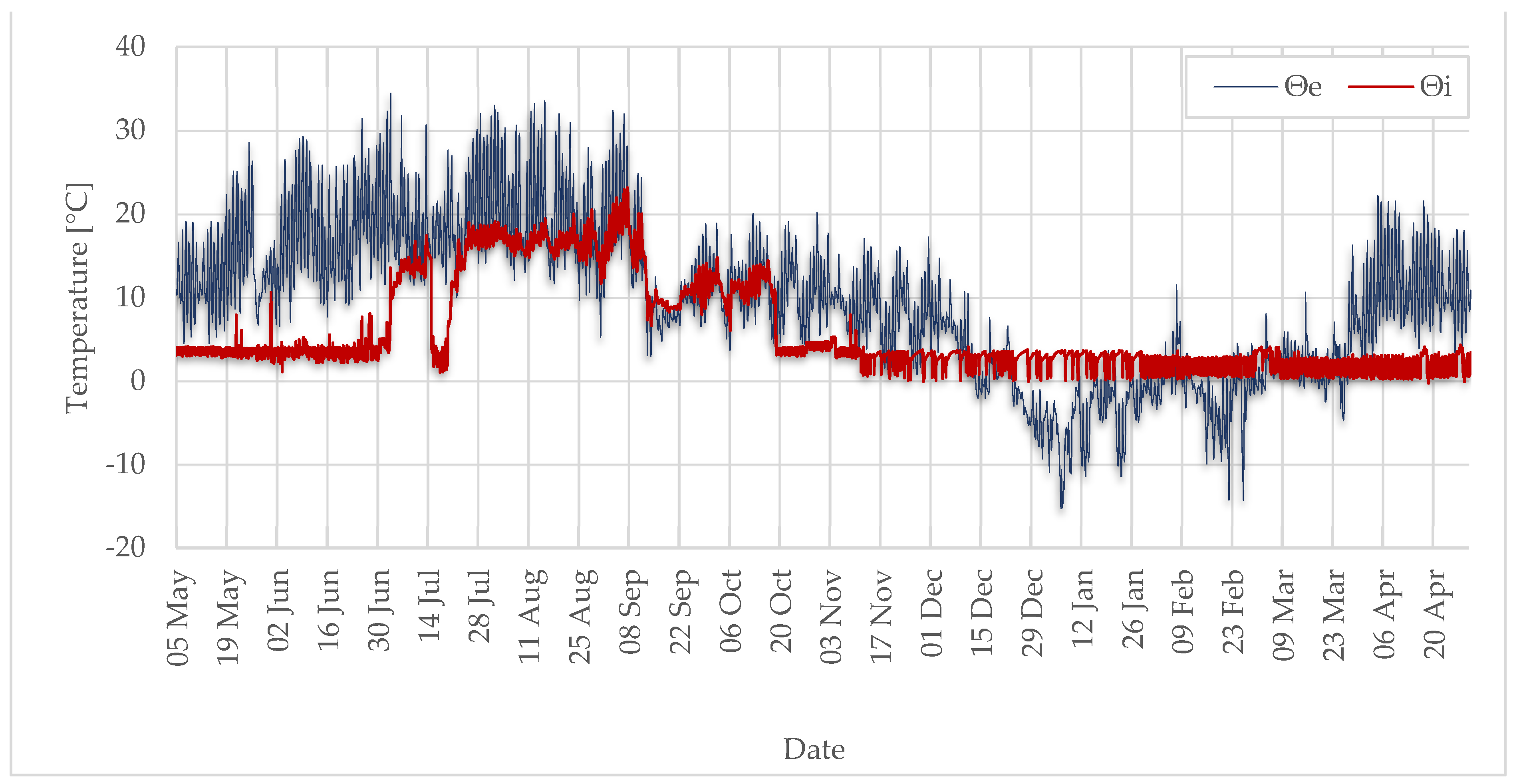
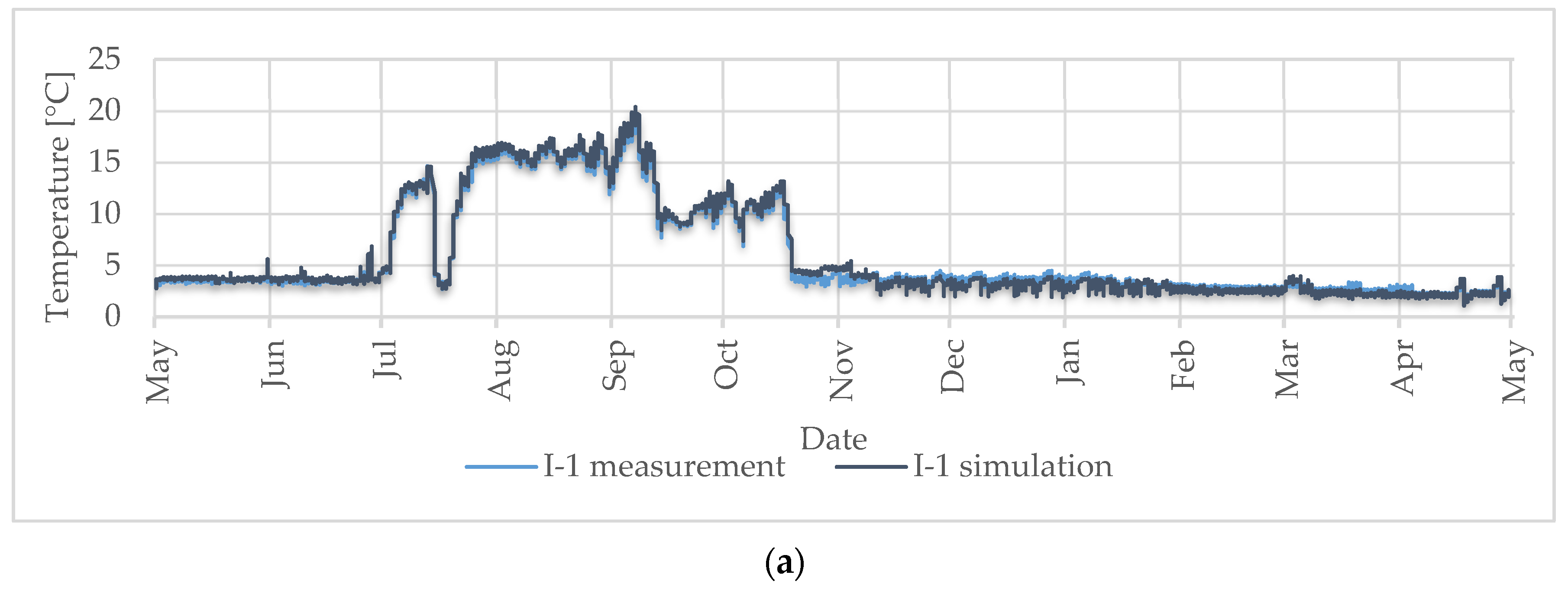



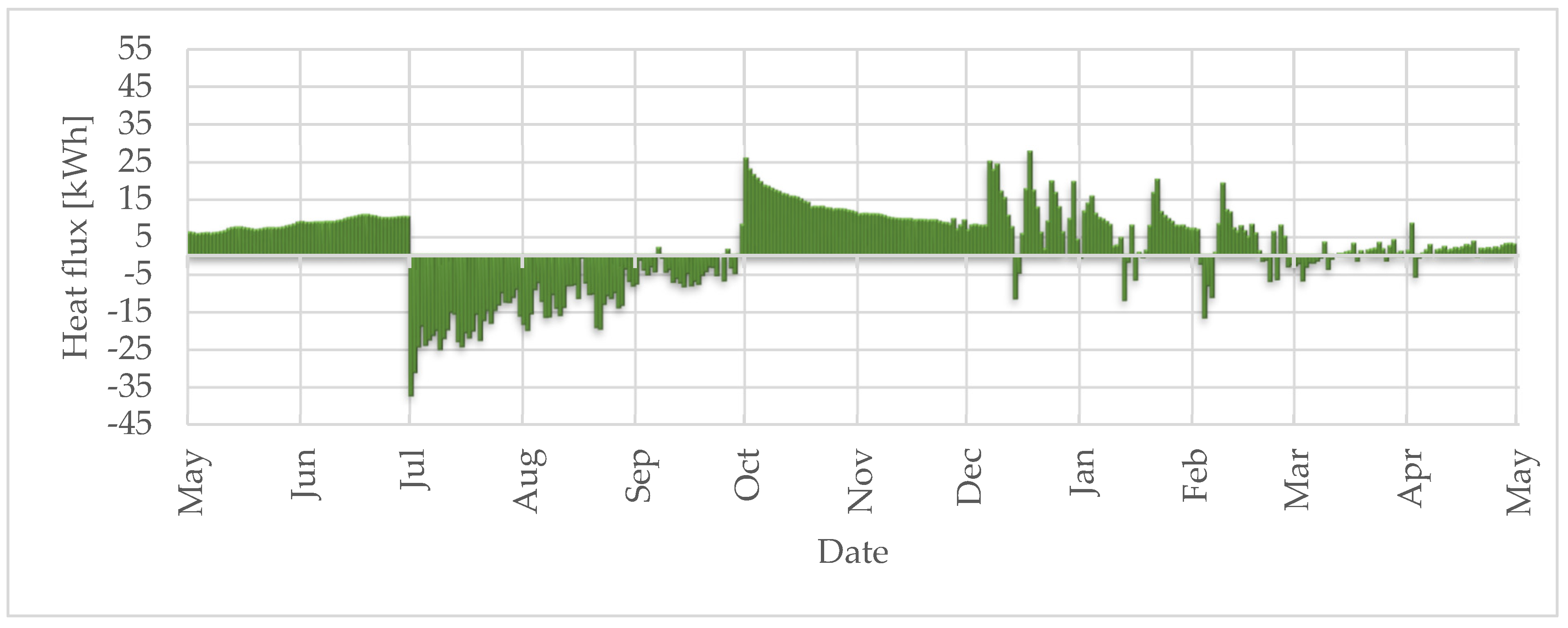

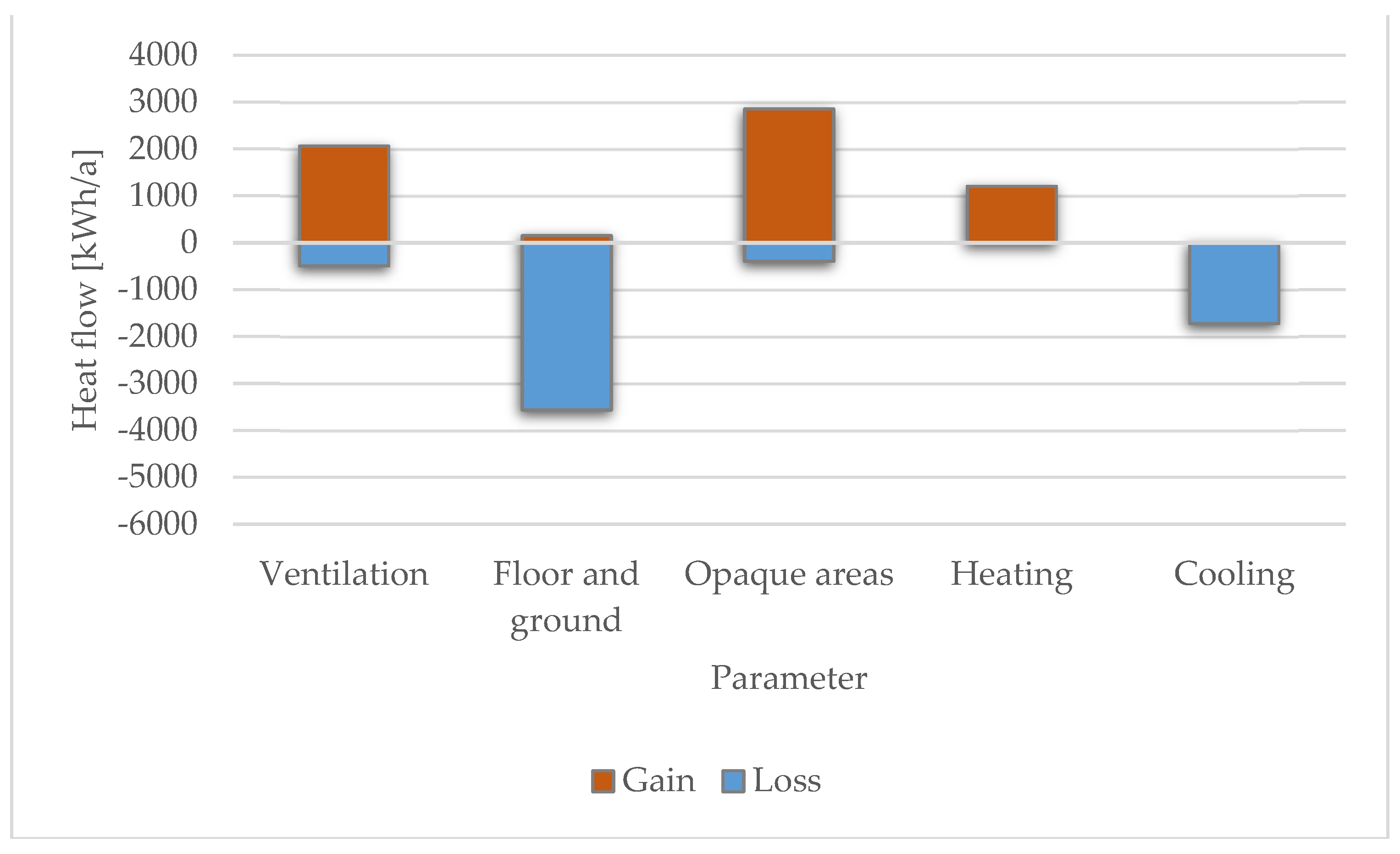
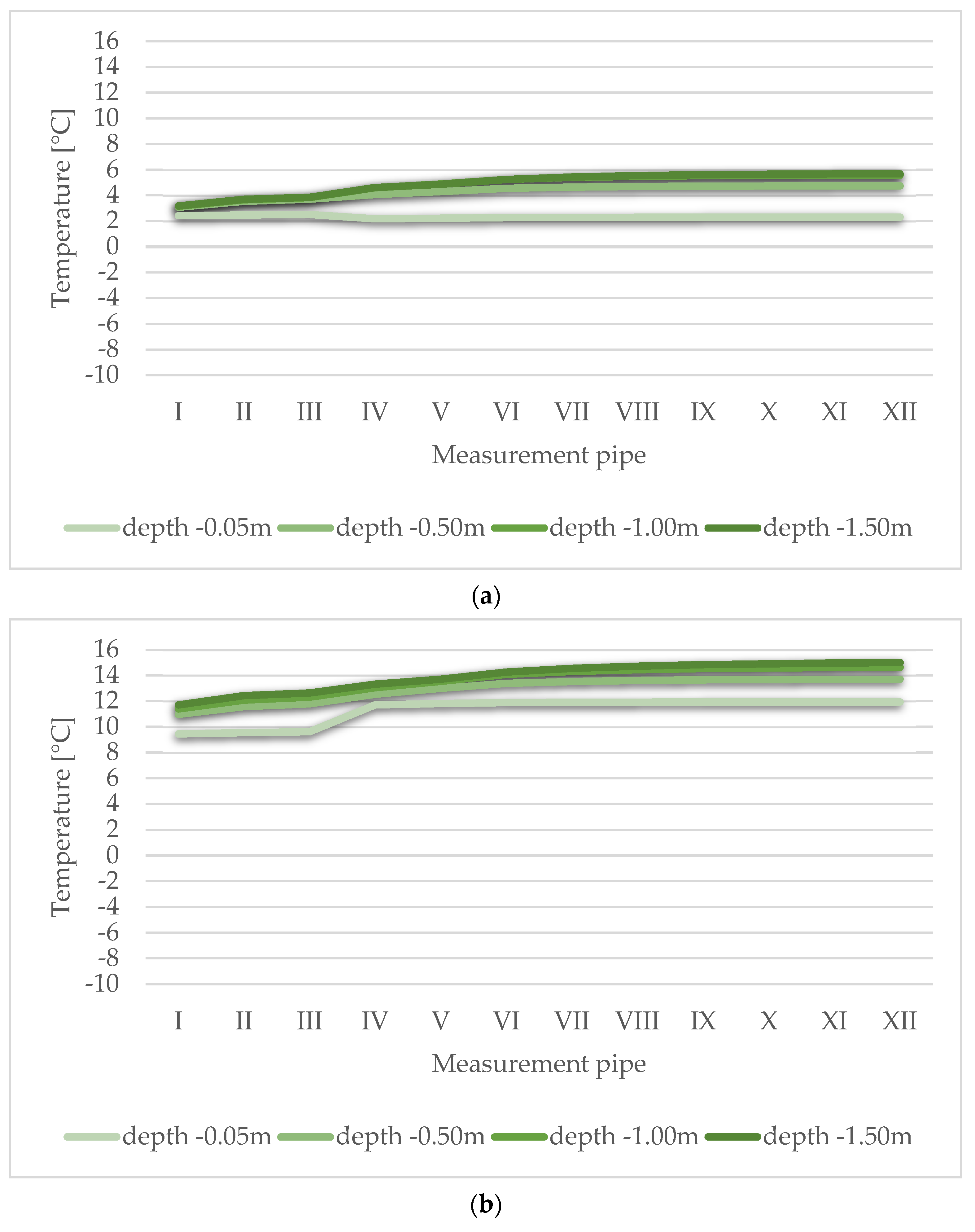
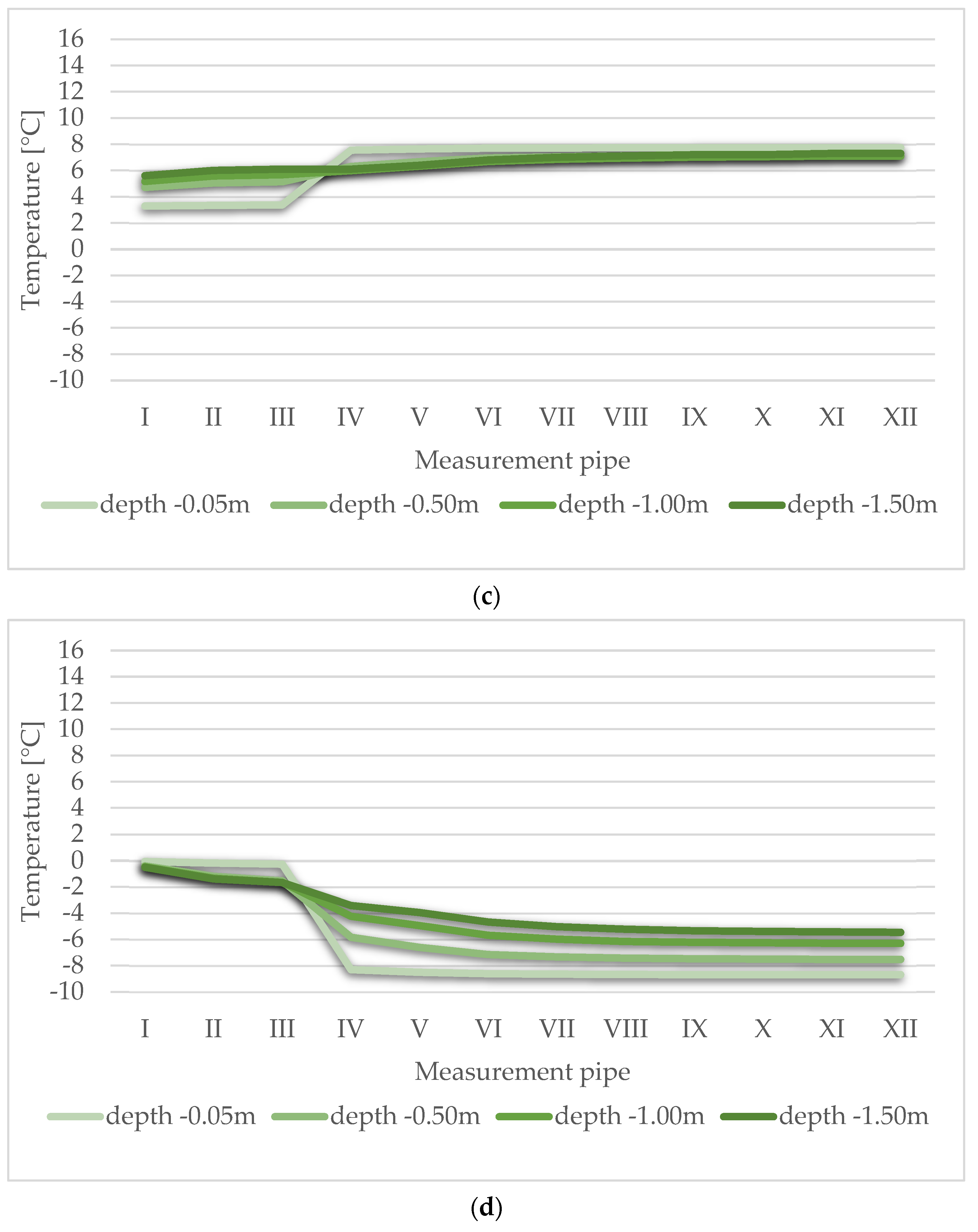
| Specification | Unit | Value | |
|---|---|---|---|
| loamy clay | volumetric weight | kg·m−3 | 1600 |
| specific heat | J·kg−1·K−1 | 1000 | |
| thermal conductivity coefficient | W·m−1·K−1 | 1.80 | |
| humus | volumetric weight | kg·m−3 | 1800 |
| specific heat | J·kg−1·K−1 | 1260 | |
| thermal conductivity coefficient | W·m−1·K−1 | 0.90 | |
| polystyrene | volumetric weight | kg·m−3 | 20 |
| specific heat | J·kg−1·K−1 | 1500 | |
| thermal conductivity coefficient | W·m−1·K−1 | 0.04 | |
| concrete | volumetric weight | kg·m−3 | 2300 |
| specific heat | J·kg−1·K−1 | 1000 | |
| thermal conductivity coefficient | W·m−1·K−1 | 2.30 | |
| gravel ballast | volumetric weight | kg·m−3 | 1800 |
| specific heat | J·kg−1·K−1 | 840 | |
| thermal conductivity coefficient | W·m−1·K−1 | 0.90 | |
| steel | volumetric weight | kg·m−3 | 7900 |
| specific heat | J·kg−1·K−1 | 460 | |
| thermal conductivity coefficient | W·m−1·K−1 | 17.00 | |
| Data Type | Uncertainty Index | FEMP 3.0 | ASHRAE G14-2014 | IPMVP |
|---|---|---|---|---|
| Hourly criteria (%) | NMBE | ±10 | ±10 | ±5 |
| CV (RMSE) | ±30 | ±30 | ±20 |
Disclaimer/Publisher’s Note: The statements, opinions and data contained in all publications are solely those of the individual author(s) and contributor(s) and not of MDPI and/or the editor(s). MDPI and/or the editor(s) disclaim responsibility for any injury to people or property resulting from any ideas, methods, instructions or products referred to in the content. |
© 2023 by the authors. Licensee MDPI, Basel, Switzerland. This article is an open access article distributed under the terms and conditions of the Creative Commons Attribution (CC BY) license (https://creativecommons.org/licenses/by/4.0/).
Share and Cite
Sokołowski, P.; Jakubowski, T.; Nawalany, G.; Atilgan, A.; Syrotyuk, S. Numerical Analysis of the Effect of Floor Depression on the Extent of Thermal Interaction with the Ground and Energy Management Using a Vegetable Cold Store as an Example. Energies 2024, 17, 5. https://doi.org/10.3390/en17010005
Sokołowski P, Jakubowski T, Nawalany G, Atilgan A, Syrotyuk S. Numerical Analysis of the Effect of Floor Depression on the Extent of Thermal Interaction with the Ground and Energy Management Using a Vegetable Cold Store as an Example. Energies. 2024; 17(1):5. https://doi.org/10.3390/en17010005
Chicago/Turabian StyleSokołowski, Paweł, Tomasz Jakubowski, Grzegorz Nawalany, Atilgan Atilgan, and Serhiy Syrotyuk. 2024. "Numerical Analysis of the Effect of Floor Depression on the Extent of Thermal Interaction with the Ground and Energy Management Using a Vegetable Cold Store as an Example" Energies 17, no. 1: 5. https://doi.org/10.3390/en17010005
APA StyleSokołowski, P., Jakubowski, T., Nawalany, G., Atilgan, A., & Syrotyuk, S. (2024). Numerical Analysis of the Effect of Floor Depression on the Extent of Thermal Interaction with the Ground and Energy Management Using a Vegetable Cold Store as an Example. Energies, 17(1), 5. https://doi.org/10.3390/en17010005







